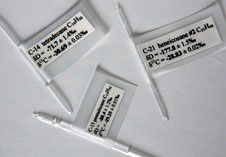Higher n-alkanes
Higher n-alkanes are available either pure as liquid or solid substances, or as dissolved mixtures of selected n-alkanes in hexane (mixtures are discussed separately below). Pure n-alkanes are flame-sealed in glass ampoules or capillaries, or crimp-sealed in glass vials. Some n-alkanes are stored as a drop of solidified wax at the end of a glass stick inside of a crimp-sealed glass vial. Hexatriacontane (i.e. C-36n-alkane) is a lightweight powder that may be difficult to weigh. I recommend to gently melt the powder and pour the melt onto a sheet of cold and clean (e.g., pre-annealed) heavy-duty aluminum foil. The solidified wax can be peeled off easily, fragmented, and filled back into a glass vial.



